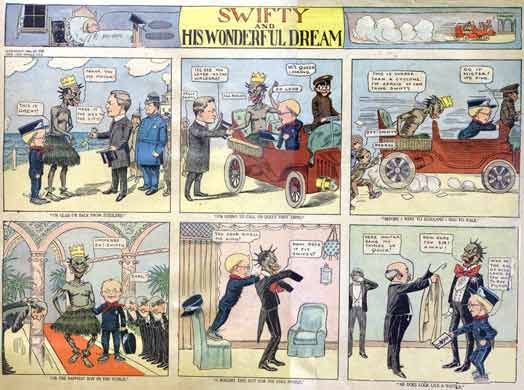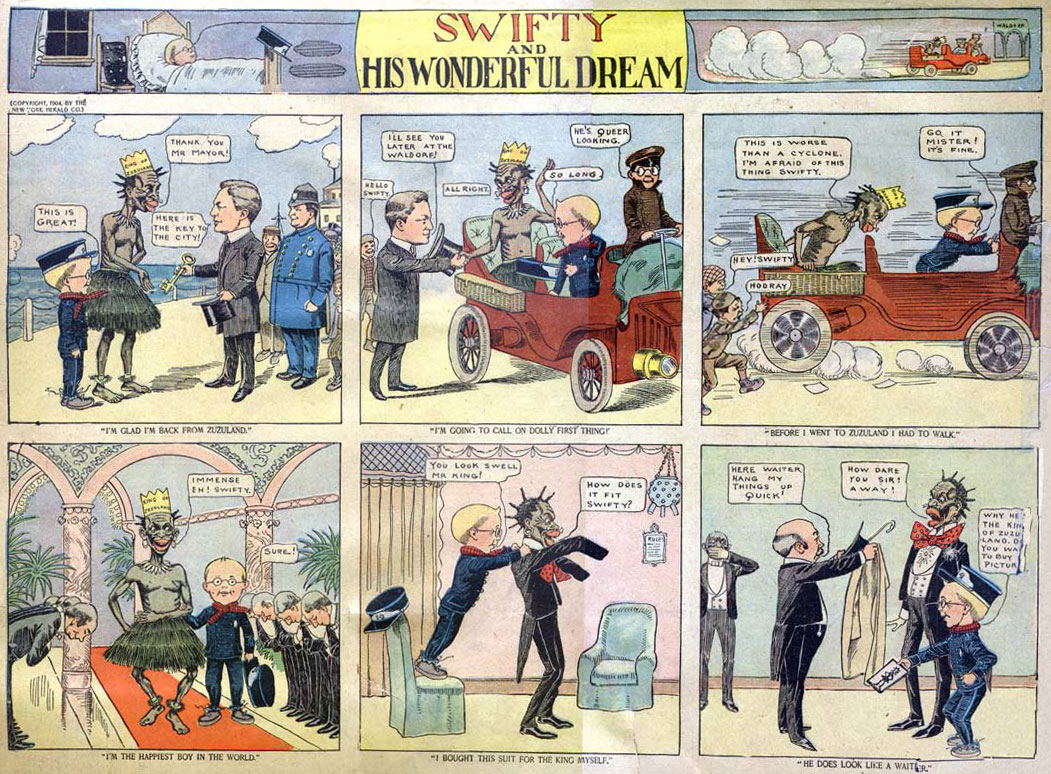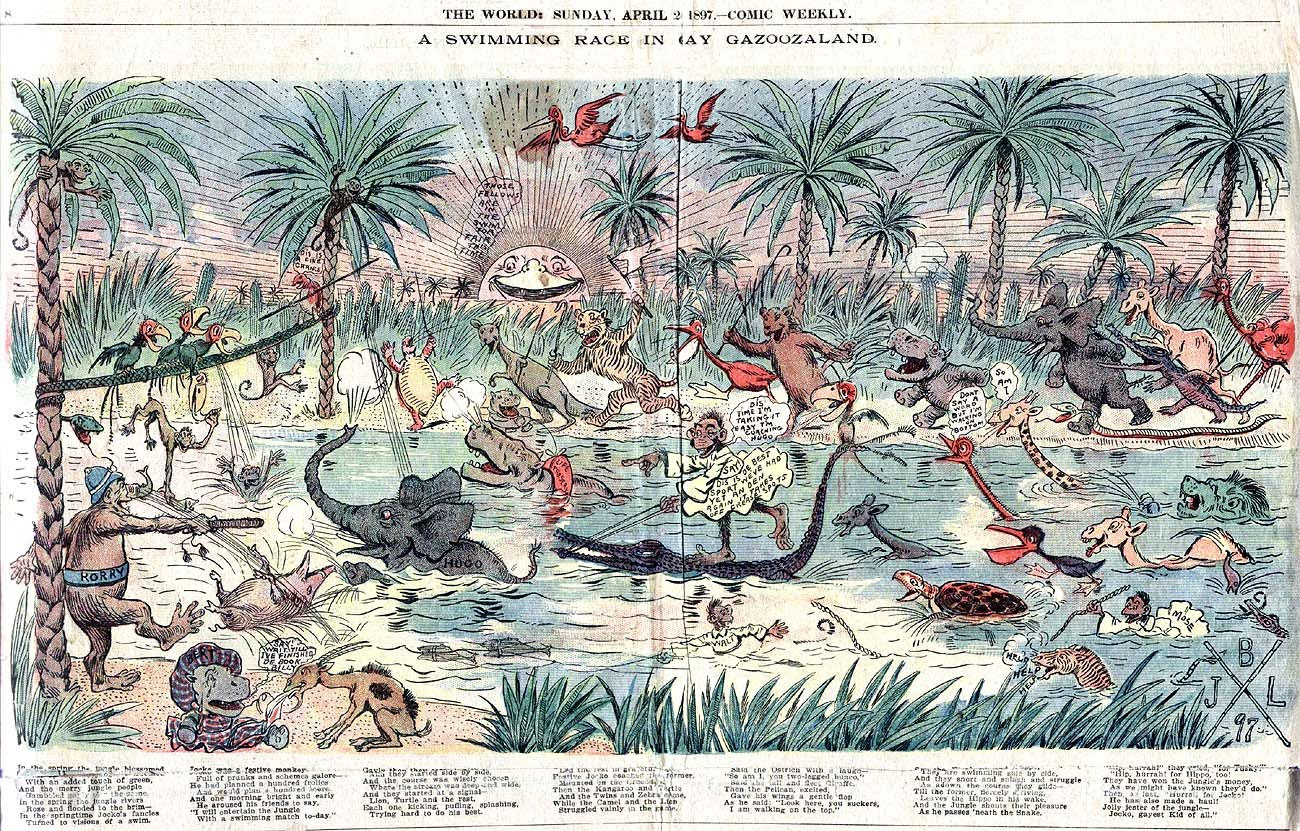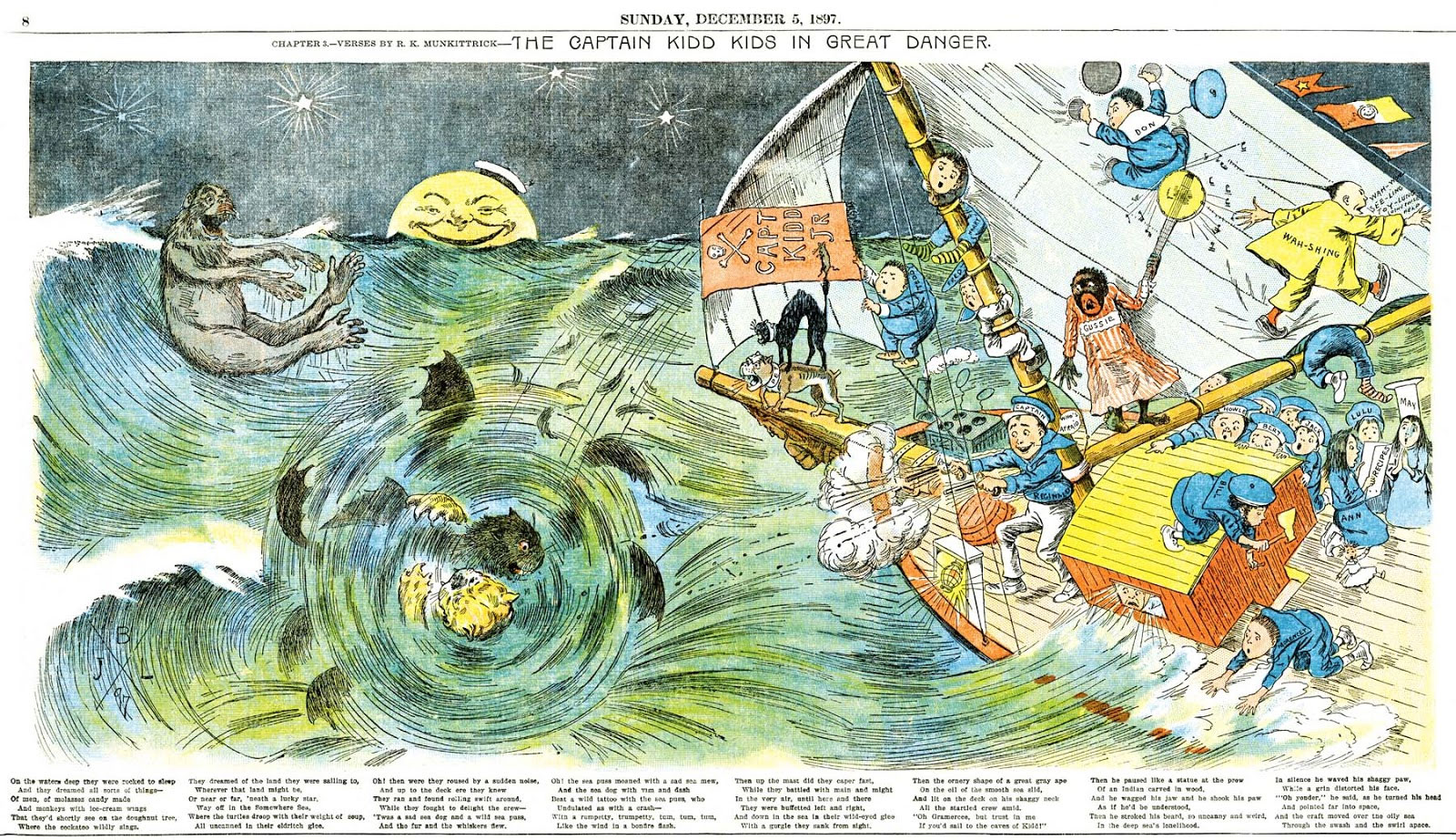'Swifty and his Wonderful Dream', The New York Herald, 1904. The man with the top hat is a caricature of George McClennan, mayor of New York City.
J.B. Lowitz was a late 19th-century, early 20th-century American newspaper cartoonist. During the 1890s, he created several short-lived comic features for the New York World, including 'Gay Gazooland' (1896-1897), 'The Never-Was People' (1897) and 'The Captain Kidd Kids' (1897-1898). In the New York Herald, he subsequently created 'Swifty and his Wonderful Dream' (1903-1904). Lowitz was one of the earliest U.S. newspaper cartoonists to use "to be continued…" at the end of a serialized episode.
Early life
John Buckingham Lowitz, nicknamed "Swifty", was born in 1873 in New York City. His father Deny Lowitz (1837-1892) was a German-born engineer, who traveled around a lot. During the summer of 1889, the family was in Paris during the World Exhibition, where the iconic Eiffel Tower was first presented to the general public. The U.S. inventor Thomas Alva Edison was also at the Exhibition to present his latest invention, the phonograph. As he spoke English, French and German, John's older brother Robert, nineteen at the time, was hired by Edison to demonstrate the object to the international visitors at the Eiffel Tower. Originally, the Eiffel Tower was only intended as a temporary exhibit, and Deny Lowitz was part of a team of engineers who would dismantle the construction after the Exhibition and rebuild it in the United States. Given the polarized reactions of people against "that ugly monstrosity", it seemed like a done deal, but once it was decided that its high peak was the ideal spot to place a radio antenna, it was decided that Eiffel Tower stayed in Paris.
New York World
A year later, the Lowitz family returned to New York City and by 1892, they lived in Brooklyn. In 1894, John Lowitz married Louise Morris, after which he tried his hand in cartooning. He found a spot in Joseph Pulitzer's New York World and its newly launched Sunday comics supplement. Throughout the decade, Lowitz contributed several comic and cartoon features, all of which had a relatively short lifespan. Between 23 February and 29 March 1896, the World ran Lowitz's Sunday cartoon panel 'The Cathode Ray'. Equally short-lived was another cartoon panel, 'The Never-Was People', which ran from 2 May through 27 June 1897.
'Gay Gazoozaland' (image source: Stripper's Guide).
Gay Gazooland
In between, from 21 June 1896 to 7 November 1897, John B. Lowitz launched a feature with a slightly longer durability. The cartoonist's marvellously illustrated funny animal cartoon series 'Gay Gazoozaland' (1896-1897) ran not only in the New York World, but also in the St. Louis Post-Dispatch. Set in an exotic jungle, the feature generally consisted of a single but detailed illustration, with text printed underneath the image. However, some characters make occasional use of speech balloons. The exact running dates remain unclear. In Ken Barker's index for publications in the New York World, 'Gay Gazooland' is believed to have run either from 21 June 1896 to 16 May 1897, or from 28 February to 7 November 1897. Allan Holtz of the Strippers Guide blog found another source which confirmed this final date as indeed the series' last episode. However, that final episode was ghosted by Daniel McCarthy.
Around the same time, Lowitz allegedly also made a comic strip named 'In the Jungle' (1896), although this might be 'Gay Gazoozaland' under another title.
The Captain Kidd Kids
Between 21 November 1897 and 9 January 1898, Lowitz continued his work for the New York World with 'The Captain Kidd Kids', a treasure hunt serial featuring a children's adventure club. Given the time period, the club is notable for being a mixture of boys and girls, with one black boy, Gussie, and an Asian one, Wah-Shing. The gang seeks the lost fortune of the legendary real-life pirate William Kidd. Traveling by ship, they cross the oceans, while being confronted with various creepy monsters. Each episode is presented as one large color drawing, with a text caption underneath the image. To help identification, the children's names can be read on their shirts. Set entirely to rhyme, the narration was scripted by the British novelist Richard Kendall Munkittrick (1853 -1911) who at the time was working as an editor for the satirical magazine Puck.
'The Captain Kidd Kids' is notable for being one of the earliest known newspaper comics told in episodes, with young readers being informed that the story will "be continued" in the next issue. While the young protagonists found the pirate treasure in the final episode, the story ended rather abruptly. Despite another "to be continued…" caption, Lowitz and Munkittrick never made any new stories. Still, 'The Captain Kidd Kids' can be regarded as a predecessor to similar children's adventure comics, such as Lyonel Feininger's 'The Kin-der-Kids' (1906-1907) in the Chicago Sunday Tribune.
'The Captain Kidd Kids' (5 December 1897, image source: Stripper's Guide).
Barnyard Club
After 'The Captain Kidd Kids', Lowitz created 'Barnyard Club' for The New York World. Serialized between 15 May and 19 June 1898, It was thematically a continuation of his earlier funny animal comic 'Gay Gazoozaland', only not set in a jungle, but on a farm. Interestingly enough, Richard F. Outcault launched his similarly titled strip 'The Barnyard Club' in The Philadelphia Courier, which ran from 17 July to 6 November 1898.
Swifty and His Wonderful Dream
John B. Lowitz's last known work for the New York World was 'Bill, the Collector of Bills', a weekday strip running from 4 April through 16 May 1903. After that, he left the Pulitzer papers and joined the New York Herald, published by James Gordon Bennett. For this paper, Lowitz created 'Swifty and His Wonderful Dream', a fantasy comic by Lowitz debuting on 6 December 1903 and running up until 22 May 1904. The title character was a young messenger boy, whose name was inspired by the cartoonist's own nickname. In each episode, he had a dream, which allowed for many imaginative storylines. Thematically, the comic is reminiscent of Winsor McCay's far more iconic 'Little Nemo in Slumberland' (1905-1914), which debuted in the same New York Herald about a year later. By then, John B. Lowitz had presumably left the field of cartooning.
Later life and death
Around the turn of the century, the Lowitz couple had relocated to Orvil, New Jersey, where John worked as a clerk in a dry goods store. About ten years later, John Lowitz was working as a bonds broker in Manhattan, New York. After his military draft during the First World War, Lowitz worked as a banking stock teller at Carlisle, Millick & Company in New York City. He was also active as a composer, writing the music for the songs 'My Little Java Lady' (lyrics by Ed Rose, 1904), 'Don't Argify' (lyrics by May Irwin, 1905), 'Hello! Peaches!' (lyrics by Henry A. Blumenthal, 1906), 'I'm Crazy 'Bout A Big Brass Band' (1906) and 'I'm Goin' To Go' (1908). By the late 1920s, the Lowitz family moved to Connecticut, where they ran the Green Kettle Inn on the old Boston Post Road in Wapping.
John Buckingham Lowitz is believed to have died on 13 February 1941. However, there might be some family confusion, as his older brother Robert MacLennan Lowitz passed away in St. Petersburg, Florida, on 17 February 1941.
J.B. Lowitz.






